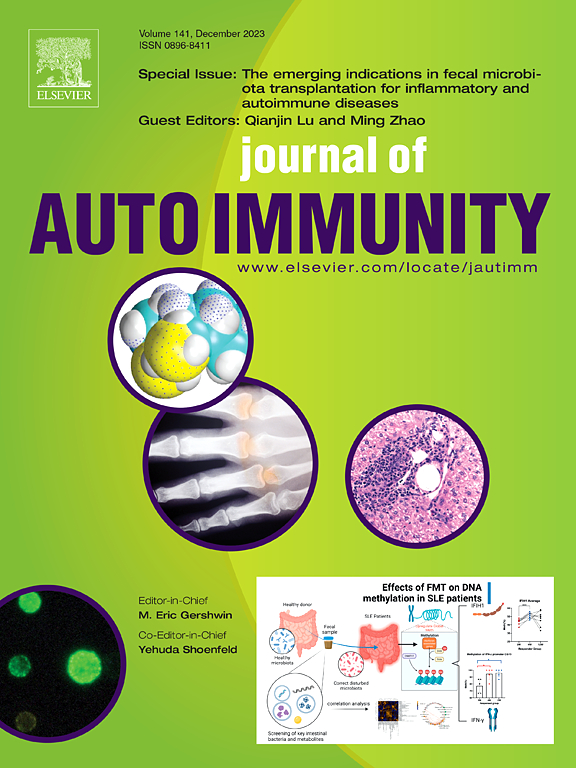肉样瘤病的感染性和非感染性诱因。
IF 7
1区 医学
Q1 IMMUNOLOGY
引用次数: 0
摘要
肉样瘤病是一种慢性炎症性疾病,可影响人体任何器官。其确切病因尚不清楚,但据信是由遗传和环境因素共同作用的结果。肉样瘤病的一些潜在病因包括遗传、环境诱因、免疫系统功能紊乱、肠道微生物组、性别和种族/民族。基因突变与防止疾病恶化或增加对更严重疾病的易感性有关,而接触某些化学物质、细菌、病毒或过敏原则会在不同器官中引发免疫细胞聚集(肉芽肿)的形成。免疫系统功能失调,包括自身免疫反应,也可能是诱因之一。肠道微生物群以及女性或非裔美国人、斯堪的纳维亚人、爱尔兰人或波多黎各人等因素也是导致疾病的因素。最近的研究表明,某些药物,如抗程序性死亡-1(PD-1)和抗生素,如结核(TB)药物,可能会增加罹患肉样瘤病的风险。激素水平,尤其是女性体内较高水平的雌激素和孕激素,也与肉样瘤病的发病几率增加有关。肉样瘤病的诊断需要进行全面的评估,包括病史、体格检查、实验室检查和影像学检查。虽然肉样瘤病无法治愈,但通常可以通过各种治疗方案有效控制症状。治疗可能涉及使用药物、外科手术或改变生活方式。这些不同的因素表明,肉样瘤病对疾病的严重程度有多种积极和消极的加重因素,其中一些可以改善,另一些则不能。本文章由计算机程序翻译,如有差异,请以英文原文为准。
Infectious and non-infectious precipitants of sarcoidosis
Sarcoidosis is a chronic inflammatory disease that can affect any organ in the body. Its exact cause remains unknown, but it is believed to result from a combination of genetic and environmental factors. Some potential causes of sarcoidosis include genetics, environmental triggers, immune system dysfunction, the gut microbiome, sex, and race/ethnicity. Genetic mutations are associated with protection against disease progression or an increased susceptibility to more severe disease, while exposure to certain chemicals, bacteria, viruses, or allergens can trigger the formation of immune cell congregations (granulomas) in different organs. Dysfunction of the immune system, including autoimmune reactions, may also contribute. The gut microbiome and factors such as being female or having African American, Scandinavian, Irish, or Puerto Rican heritage are additional contributors to disease outcome. Recent research has suggested that certain drugs, such as anti-Programmed Death-1 (PD-1) and antibiotics such as tuberculosis (TB) drugs, may raise the risk of developing sarcoidosis. Hormone levels, particularly higher levels of estrogen and progesterone in women, have also been linked to an increased likelihood of sarcoidosis. The diagnosis of sarcoidosis involves a comprehensive assessment that includes medical history, physical examination, laboratory tests, and imaging studies. While there is no cure for sarcoidosis, the symptoms can often be effectively managed through various treatment options. Treatment may involve the use of medications, surgical interventions, or lifestyle changes. These disparate factors suggests that sarcoidosis has multiple positive and negative exacerbants on disease severity, some of which can be ameliorated and others which cannot.
求助全文
通过发布文献求助,成功后即可免费获取论文全文。
去求助
来源期刊

Journal of autoimmunity
医学-免疫学
CiteScore
27.90
自引率
1.60%
发文量
117
审稿时长
17 days
期刊介绍:
The Journal of Autoimmunity serves as the primary publication for research on various facets of autoimmunity. These include topics such as the mechanism of self-recognition, regulation of autoimmune responses, experimental autoimmune diseases, diagnostic tests for autoantibodies, as well as the epidemiology, pathophysiology, and treatment of autoimmune diseases. While the journal covers a wide range of subjects, it emphasizes papers exploring the genetic, molecular biology, and cellular aspects of the field.
The Journal of Translational Autoimmunity, on the other hand, is a subsidiary journal of the Journal of Autoimmunity. It focuses specifically on translating scientific discoveries in autoimmunity into clinical applications and practical solutions. By highlighting research that bridges the gap between basic science and clinical practice, the Journal of Translational Autoimmunity aims to advance the understanding and treatment of autoimmune diseases.
 求助内容:
求助内容: 应助结果提醒方式:
应助结果提醒方式:


